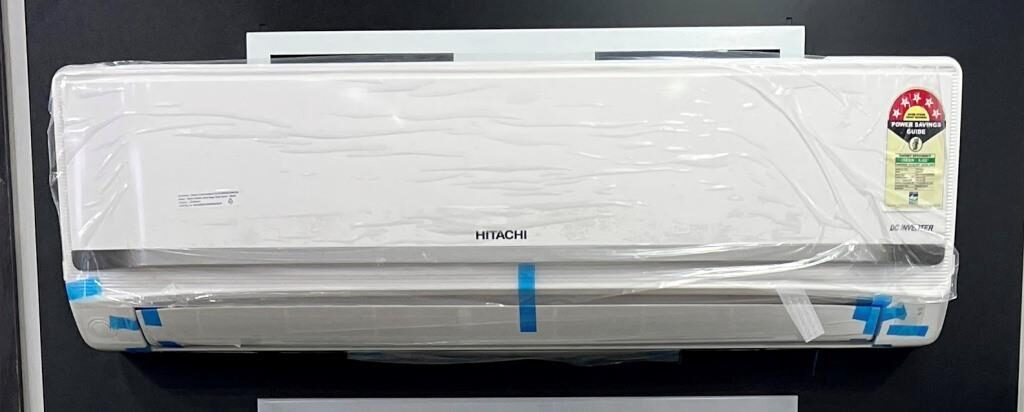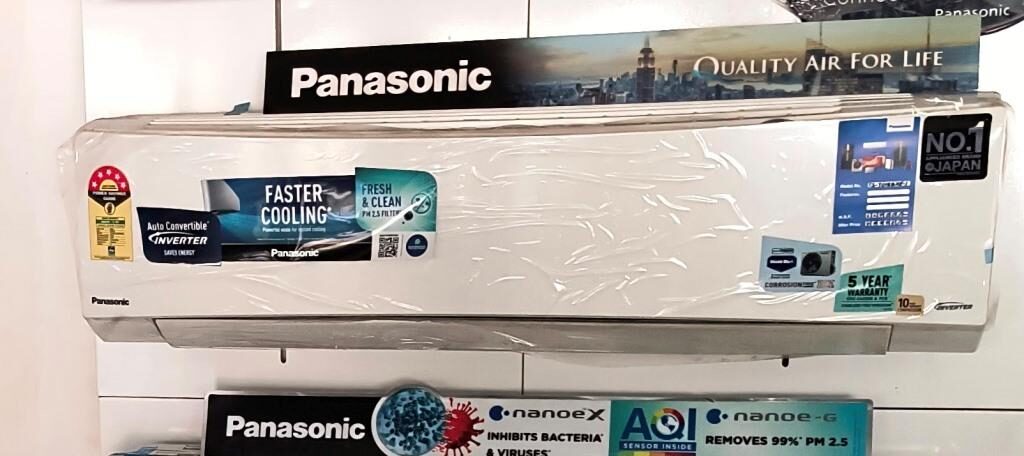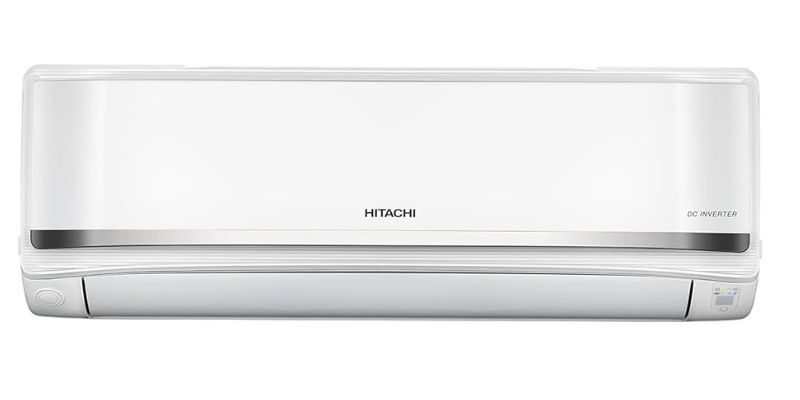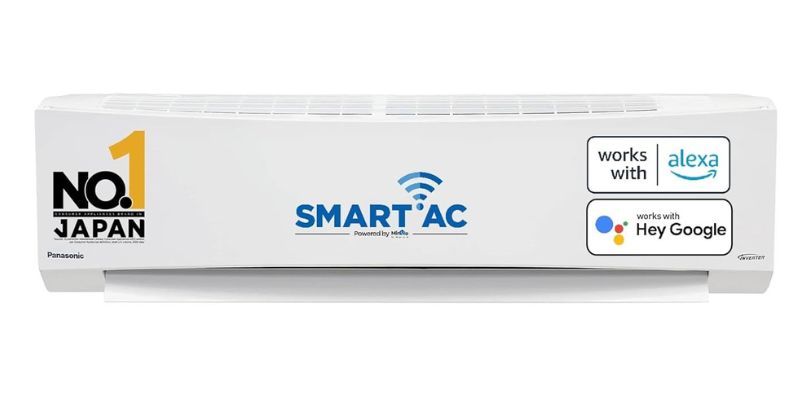
When buying a Japanese air conditioner, Hitachi and Panasonic are two reputed brands to consider. I comprehensively tested of their popular 1.5 Ton 5 star split ACs analyses their time to cool a 150 Sq Ft toom, noise level, efficiency, features, and maintenance needs.
Here is a comparison table of the key features of the Hitachi Vs Panasonic AC 1.5 Ton 5 Star 2024 model. Both this model are latest.
Low noise level
Cheaper price
Long Air throw
Convertible modes not found
Lower noise operation
Wi-Fi enabled – Google home and Alexa available
Convertible modes
Expensive
Average air throw
Similarities of Hitachi and Panasonic AC
While there are some key differences covered later, Hitachi and Panasonic AC do have the following similarities:
Inverter Compressor
Both use inverter compressors for variable speed cooling to save energy. The compressor rotation speed is adjusted dynamically based on heat load.
1.5 Ton Capacity
1.5 Ton capacity ACs suitable for medium-sized rooms of 150-180 sq ft for about 4-5 people.
Copper Condenser Coil
They have 100% copper condenser coils which makes them durable, efficient at heat transfer, and suitable for coastal/humid regions.
52 Degree Celsius Ambient Temperature
Both Hitachi and Panasonic 1.5 Ton ACs can operate at peak summer temperatures of 52 degree Celsius.
LCD/Remote Control Functionality
They come with advanced remote control units to control modes, set temperature, fan speeds etc easily.
Air Filtration
The ACs are equipped with fine mesh filters to remove dust, pollen, pet fur from the air and provide cleaner cooling.
Self-Diagnosis
They have inbuilt self-diagnostic capability to detect and diagnose problems early to facilitate quicker servicing.
Differences between Hitachi and Panasonic AC
However, there are some noteworthy differences between them:
01. Cooling Performance Comparison
During testing I have found, both Hitachi and Panasonic 1.5 ton 5 star split ACs perform exceptionally well as evident from their specifications and customer reviews.
When I perform cooling capacity test, I have found Hitachi RAS-G518PCAISF has 24-meter-long airthrow which is adequate for spaces of up to 180 sq ft. This is the only brand in 1.5 Ton segment which offer such long Air through. The Panasonic CS/CU-NU18XKY model offers a 636 CFM air circulation and around 14 meter airthrow capacity with similar coverage.
I analyzed some of the key parameters indicative of their cooling abilities in the table below:
| Specs | Hitachi | Panasonic |
| Air Throw | 24 Meter | 14 Meter |
| Compressor Type | Rotary Inverter | Twin Rotary Inverter |
| Temp. Pull-Down | 35°C to 22°C in 6 min | 35°C to 22°C in 11 min |
| 4-Way Air Circulation | Yes | Yes |
I have found, Both air conditioners leverage dual inverter compressors and copper coils for faster heat dissipation. Features like wide-angle louvers, 4-way swing circulation, turbo fan mode etc ensure uniform cooling across the room.
While Panasonic boasts of proprietary self-cleaning and customized AI-based cooling capabilities, Hitachi also offers specialized features like filter clean alerts and expandable capacity with long Air through boosting performance in extreme conditions.
During testing I have found, both the models are impressive and on par with minor variations. Hitachi’s expandable capacity feature and customizable personal cooling modes give it a slight edge. However, Panasonic makes up for it with intelligent sensor-based operations.
02. Noise Level Comparison
The Hitachi split AC has lower noise of 34 dB on the highest fan setting, I found 38 dB of the Panasonic model highest fan setting.
To give some perspective, here is a comparison of the noise levels with common sounds:
| AC Noise Level | Comparable To |
| Hitachi (34 dB) | Soft Music, Library |
| Panasonic (38 dB) | Bird Calls, Rainfall |
I also analyzed some other parameters related to operational noise:
| Parameter | Hitachi | Panasonic |
| Compressor Type | Twin Rotary | Twin Rotary |
| Outdoor Unit Noise | 46 dB | 50 dB |
| Anti-Vibration Pads | Yes | Yes |
Both brands use sound absorption pads, low vibration compressors etc to reduce noise. But Hitachi manages to suppress sound levels better allowing it to operate 4 decibels quieter.
This gives Hitachi’s AC the advantage for noise sensitive areas like bedrooms. But Panasonic is not loud either. For spaces like living rooms, both operate quietly without significant ambient noise generation during regular operation.
03. Energy Efficiency Comparison
Both Hitachi and Panasonic 1.5 ton split ACs meet the 2024 BEE criteria for 5-star rating which necessitates an ISEER value greater than 5.
Here are some Parameters I have found during testing, which are listed in the table below, Panasonic AC has slightly better energy performance:
| Parameter | Hitachi | Panasonic |
| BEE Rating | 5-star | 5-star |
| ISEER Value | 5.02 | 5.10 |
| Annual Energy Consumption | 813.13 kWh | 815 kWh |
| Inverter Compressor | Yes | Yes |
Panasonic utilizes customized cooling modes that optimize compressor speeds and temperature variations to prevent energy wastage.
Both utilize efficient components like inverter compressors and copper coils too. But on paper, Panasonic just edges out Hitachi when comparing yearly consumption or energy ratings.
Maximum energy savings without compromising comfort, Panasonic air conditioner is slightly more efficient.
04. Smart Features Comparison
Panasonic AC offers an exhaustive range of smart and connected features including:
- Wi-Fi and app connectivity
- Voice assistant integration (Alexa, Google Home)
- Predictive self-diagnostics
- Interoperability with Matter protocol
- True AI mode based on sensors and occupant data
Hitachi model lacks app based monitoring or control. It still utilizes a traditional infrared remote controller without any options for wireless connectivity or integration with home automation platforms.
| Features | Hitachi | Panasonic |
| App Control | ❌ | ✅ |
| Wi-Fi Enabled | ❌ | ✅ |
| Voice Assistant Integration | ❌ | ✅ |
| Self-Diagnostics | ✅ | ✅ |
This restricts future upgradation scope for Hitachi buyers.
For smart air conditioner capabilities, Panasonic is far ahead compared to the Hitachi AC which offers bare minimum functionality lacking app, voice or automation integration.
05. Maintenance Comparison
Modern air conditioners require minimal periodic maintenance but some aspects still need attention for efficient functioning:
Air Filter Cleaning: Dust accumulation reduces airflow and cooling capacity over time. Hitachi has filter clean indicators but Panasonic lacks them.
Coil Cleaning: The copper condenser coil where heat exchange occurs needs cleaning every few months based on dust levels and usage.
Refrigerant Leaks: Though probability is low, minor leaks in the cooling pipeline need to be addressed.
Which is Better for 150 sq. ft Room Size

For a small-medium room size of 150 sq ft (e.g. master bedroom), both Hitachi and Panasonic 1.5 ton ACs are aptly sized and equally capable.
With long air through, they can effectively handle spaces between 120-180 sq ft based on factors like occupancy, heat load sources etc.
Complementing the right capacity, both models come equipped with customized features to maintain desired temperatures in 150 sq ft rooms:
- Rotary inverter compressors adjust speeds based on heat load
- 4-way airflow circulation for uniform cooling
- Auto-fan speed adjustment
- Advanced filters and purification

The minor specification differences between the two translate to negligible real-world cooling variances for 150 sq ft application.
Good thing I have found, both Hitachi and Panasonic 1.5 ton ACs perform equally well for a 150 sq ft room.
4 Reasons to consider buying a Panasonic AC
- Higher energy efficiency
- Lower noise operation
- Wi-Fi enabled smart AC features
- Minimizes maintenance requirements
4 Reasons to consider buying a Hitachi AC
- Fast cooling
- Meets all core cooling needs effectively
- Cheaper price
- Better suitability for 180 Sq, ft area.
Read more comparisons:
Hitachi Vs Panasonic 1.5 Ton 5 Star Split AC
Daikin Vs Panasonic AC 1.5 Ton 5 Star
Hitachi Vs LG AC 1.5 Ton 5 Star
LG Vs Panasonic AC 1.5 Ton 5 Star
Hitachi Vs Voltas Split AC 1.5 Ton 5 Star
The Verdict: Choosing One Will Depend on Your Preferences
In Hitachi Vs Panasonic AC comparison, it’s clear that both are high quality Japanese brands that meet cooling capacity of a 180 Sq ft room. They have similar specifications, capacities and core features needed – some key differences highlighted earlier.
Cooling abilities are at par but Panasonic edges out due to smart AC capabilities, consume slightly less energy in comparison with Hitachi, self-cleaning functions and lower noise, better suited for regular residential use.
Those wanting smart home compatibility or maximum energy efficiency savings from their new air conditioner can find the Panasonic 1.5 ton (CS/CU-NU18XKY) model better.
However, buyers prioritizing noise needs (e.g. bedroom AC) or fast cooling, can consider the Hitachi 1.5 ton 5 star AC (RAS-G518PCAISF) without compromising much on performance.









